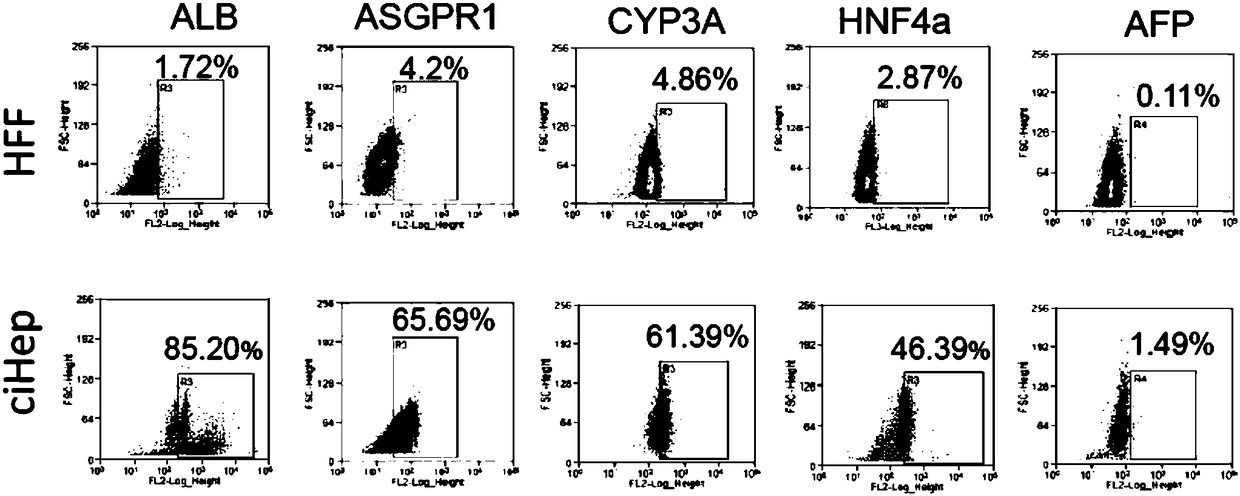Method for inducing direct reprogramming of human fibroblasts into hepatic cells by small molecules
A technology of human fibroblasts and fibroblasts, applied in artificial cell constructs, animal cells, vertebrate cells, etc., can solve the problems of low differentiation efficiency, high cost, and incomplete differentiation of stem cells
- Summary
- Abstract
- Description
- Claims
- Application Information
AI Technical Summary
Problems solved by technology
Method used
Image
Examples
preparation example Construction
[0144] The preparation method of the composition of the present invention is determined according to the dosage form to be prepared and the route of administration. Those skilled in the art can use the conventional preparation method of the pharmaceutical composition after referring to the combination and proportioning provided by the present invention. Compositions of the present invention are prepared.
[0145] It should be understood that although in the specific embodiment, the inventor has listed several composition forms, those skilled in the art can also deduce from this that any other combination form of the present invention also has outstanding effects.
[0146] The inventors firstly confirmed that the small molecule composition of the present invention can be used to develop and prepare drugs or drug formulations for preventing, improving or treating liver fibrosis or chronic liver failure. When used to prevent, improve or treat liver fibrosis, or chronic liver fail...
Embodiment 1
[0181] Example 1. Small molecule composition for direct reprogramming (transdifferentiation) of human fibroblasts induced by small molecules into hepatocytes, and preparation of medium and reagents thereof
[0182] Design the following composition or medium, which can be prepared according to molar concentration or weight concentration:
[0183] 1. Formula of small molecule composition for fibroblast transdifferentiation liver cell
[0184] (1) Fibroblast transdifferentiation liver cell composition 1
[0185] GSK3β inhibitor CHIR-99021: final concentration 5uM;
[0186] TGFβ inhibitor SB431542: final concentration 2uM;
[0187] G9aHMTase inhibitor BIX01294: final concentration 3uM;
[0188] (2) Fibroblast transdifferentiation liver cell composition 2
[0189] GSK3β inhibitor CHIR-99021: final concentration 6uM;
[0190] TGFβ inhibitor SB431542: final concentration 0.5uM;
[0191] G9aHMTase inhibitor BIX01294: final concentration 5uM;
[0192] (3) Fibroblast transdiffere...
Embodiment 2
[0223] Example 2, Fibroblast Transdifferentiation Hepatocyte Medium 6 Induces Fibroblast Transdifferentiation Hepatocyte
[0224] 1. Fibroblast transdifferentiation hepatocyte culture
[0225] The fibroblasts were suspended in the basal cell medium DMEM containing 10% calf serum, plated, and cultured at 37°C.
[0226] After the fibroblasts adhered to the wall, the original medium was discarded and replaced with fibroblast-transdifferentiated liver cell medium 6, cultured at 37°C, and the medium was changed every 3 days; passage was performed once every 7 days.
[0227] 2. Subculture of fibroblast transdifferentiated hepatocytes
[0228] Subculture steps: Discard the original culture medium, wash once with PBS, add cell digestion solution to digest the cells, stop cell digestion at 37°C for 3 minutes, centrifuge, discard the supernatant, resuspend the cell pellet, and plate at a ratio of 1:2. Replace the fibroblast transdifferentiation liver cell medium 6 for culture, and cha...
PUM
 Login to View More
Login to View More Abstract
Description
Claims
Application Information
 Login to View More
Login to View More - R&D
- Intellectual Property
- Life Sciences
- Materials
- Tech Scout
- Unparalleled Data Quality
- Higher Quality Content
- 60% Fewer Hallucinations
Browse by: Latest US Patents, China's latest patents, Technical Efficacy Thesaurus, Application Domain, Technology Topic, Popular Technical Reports.
© 2025 PatSnap. All rights reserved.Legal|Privacy policy|Modern Slavery Act Transparency Statement|Sitemap|About US| Contact US: help@patsnap.com



